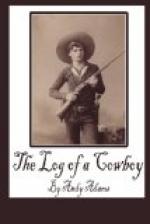“My name is Pete Slaughter,” said he, by way of introduction, “and I’ve got a herd of twenty-eight hundred beef steers, beyond the trail and a few miles back. I’ve been riding since daybreak down the creek, and I’m prepared to state that the chance of crossing is as good right here as anywhere. I wanted to see your foreman, and if he’ll help, we’ll bridge her. I’ve been down to see this other outfit, but they ridicule the idea, though I think they’ll come around all right. I borrowed their axe, and to-morrow morning you’ll see me with my outfit cutting timber to bridge Big Boggy. That’s right, boys; it’s the only thing to do. The trouble is I’ve only got eight men all told. I don’t aim to travel over eight or ten miles a day, so I don’t need a big outfit. You say your foreman’s name is Flood? Well, if he don’t return before I go, some of you tell him that he’s wasting good time looking for a ford, for there ain’t none.”
In the conversation which followed, we learned that Slaughter was driving for his brother Lum, a widely known cowman and drover, whom we had seen in Dodge. He had started with the grass from north Texas, and by the time he reached the Platte, many of his herd would be fit to ship to market, and what were not would be in good demand as feeders in the corn belt of eastern Nebraska. He asked if we had seen his herd during the morning, and on hearing we had, got up and asked McCann to let him see our axe. This he gave a critical examination, before he mounted his horse to go, and on leaving said,—
“If your foreman don’t want to help build a bridge, I want to borrow that axe of yours. But you fellows talk to him. If any of you boys has ever been over on the Chisholm trail, you will remember the bridge on Rush Creek, south of the Washita River. I built that bridge in a day with an outfit of ten men. Why, shucks! if these outfits would pull together, we could cross to-morrow evening. Lots of these old foremen don’t like to listen to a cub like me, but, holy snakes! I’ve been over the trail oftener than any of them. Why, when I wasn’t big enough to make a hand with the herd,—only ten years old,—in the days when we drove to Abilene, they used to send me in the lead with an old cylinder gun to shoot at the buffalo and scare them off the trail. And I’ve made the trip every year since. So you tell Flood when he comes in, that Pete Slaughter was here, and that he’s going to build a bridge, and would like to have him and his outfit help.”
Had it not been for his youth and perpetual smile, we might have taken young Slaughter more seriously, for both Quince Forrest and The Rebel remembered the bridge on Rush Creek over on the Chisholm. Still there was an air of confident assurance in the young fellow; and the fact that he was the trusted foreman of Lum Slaughter, in charge of a valuable herd of cattle, carried weight with those who knew that drover. The most unwelcome thought in the project was that it required the swinging of an axe to fell trees and to cut them into the necessary lengths, and, as I have said before, the Texan never took kindly to manual labor. But Priest looked favorably on the suggestion, and so enlisted my support, and even pointed out a spot where timber was most abundant as a suitable place to build the bridge.




